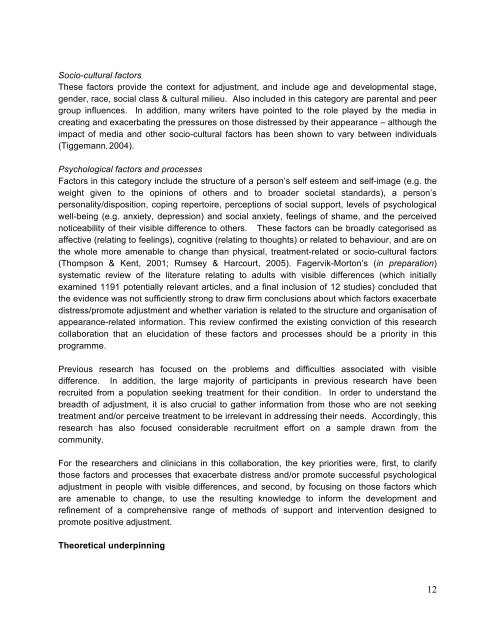Download the report - The Healing Foundation
Download the report - The Healing Foundation
Download the report - The Healing Foundation
You also want an ePaper? Increase the reach of your titles
YUMPU automatically turns print PDFs into web optimized ePapers that Google loves.
Socio-cultural factors<br />
<strong>The</strong>se factors provide <strong>the</strong> context for adjustment, and include age and developmental stage,<br />
gender, race, social class & cultural milieu. Also included in this category are parental and peer<br />
group influences. In addition, many writers have pointed to <strong>the</strong> role played by <strong>the</strong> media in<br />
creating and exacerbating <strong>the</strong> pressures on those distressed by <strong>the</strong>ir appearance – although <strong>the</strong><br />
impact of media and o<strong>the</strong>r socio-cultural factors has been shown to vary between individuals<br />
(Tiggemann, 2004).<br />
Psychological factors and processes<br />
Factors in this category include <strong>the</strong> structure of a person’s self esteem and self-image (e.g. <strong>the</strong><br />
weight given to <strong>the</strong> opinions of o<strong>the</strong>rs and to broader societal standards), a person’s<br />
personality/disposition, coping repertoire, perceptions of social support, levels of psychological<br />
well-being (e.g. anxiety, depression) and social anxiety, feelings of shame, and <strong>the</strong> perceived<br />
noticeability of <strong>the</strong>ir visible difference to o<strong>the</strong>rs. <strong>The</strong>se factors can be broadly categorised as<br />
affective (relating to feelings), cognitive (relating to thoughts) or related to behaviour, and are on<br />
<strong>the</strong> whole more amenable to change than physical, treatment-related or socio-cultural factors<br />
(Thompson & Kent, 2001; Rumsey & Harcourt, 2005). Fagervik-Morton’s (in preparation)<br />
systematic review of <strong>the</strong> literature relating to adults with visible differences (which initially<br />
examined 1191 potentially relevant articles, and a final inclusion of 12 studies) concluded that<br />
<strong>the</strong> evidence was not sufficiently strong to draw firm conclusions about which factors exacerbate<br />
distress/promote adjustment and whe<strong>the</strong>r variation is related to <strong>the</strong> structure and organisation of<br />
appearance-related information. This review confirmed <strong>the</strong> existing conviction of this research<br />
collaboration that an elucidation of <strong>the</strong>se factors and processes should be a priority in this<br />
programme.<br />
Previous research has focused on <strong>the</strong> problems and difficulties associated with visible<br />
difference. In addition, <strong>the</strong> large majority of participants in previous research have been<br />
recruited from a population seeking treatment for <strong>the</strong>ir condition. In order to understand <strong>the</strong><br />
breadth of adjustment, it is also crucial to ga<strong>the</strong>r information from those who are not seeking<br />
treatment and/or perceive treatment to be irrelevant in addressing <strong>the</strong>ir needs. Accordingly, this<br />
research has also focused considerable recruitment effort on a sample drawn from <strong>the</strong><br />
community.<br />
For <strong>the</strong> researchers and clinicians in this collaboration, <strong>the</strong> key priorities were, first, to clarify<br />
those factors and processes that exacerbate distress and/or promote successful psychological<br />
adjustment in people with visible differences, and second, by focusing on those factors which<br />
are amenable to change, to use <strong>the</strong> resulting knowledge to inform <strong>the</strong> development and<br />
refinement of a comprehensive range of methods of support and intervention designed to<br />
promote positive adjustment.<br />
<strong>The</strong>oretical underpinning<br />
12


